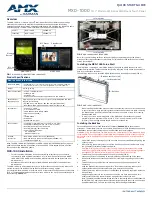
General Installation Manual
© July 1, 2008. SANYO Energy (USA) Corp. All Rights Reserved.
1
General Installation Manual for SANYO
HIT
®
Photovoltaic Modules. Please read
this manual completely before use of, or
installation of HIT Power modules. This
manual applies to the following models:
HIT Power 205
(HIP-205BA19)
HIT Power 200
(HIP-200BA19)
HIT Power 195
(HIP-195BA19)
HIT Power 190
(HIP-190BA19)
HIT Power 186
(HIP-186BA19)
HIT Power 180
(HIP-180BA19)
INTRODUCTION
Thank you for choosing SANYO HIT Power
photovoltaic (PV) modules. With proper
operation and maintenance, your solar PV
modules will provide you with clean,
renewable solar electricity for many years.
This manual contains important installation,
maintenance and safety information. The
word ―module‖ as used in this manual refers
to one or more PV modules.
Retain this
manual for future reference.
Disclaimer of Liability
SANYO does not assume responsibility and
expressly
disclaims
liability
for
loss,
damage, or expense arising out of, or in
any way connected with installation,
operation, use, or maintenance by using
this manual.
SANYO assumes no responsibility for any
infringement of patents or other rights of
third parties, which may result from use of
modules.
No license is granted by implication or
under any patent or patent rights. The
information in this manual is believed to be
reliable, but does not constitute an
expressed and/or implied warranty.
SANYO reserves the right to make changes
to the product, specifications, data sheets
and this manual without prior notice.
General Information
The installation of solar modules requires a
great degree of skill and should only be
performed
by
qualified
licensed
professionals, including, without limitation,
licensed contractors and electricians.
WARNING
All instructions should be read and
understood before attempting to
install, wire, operate, or maintain a
PV module.
Contact with electrically active parts
of the module such as terminals can
result in sparks, injury, fire, burns,
and
lethal
shock whether
the
module
is
connected
or
disconnected.
The installer assumes the risk of all
injury that might occur during
installation.
PV modules generate direct current
(DC) electrical energy when exposed
to sunlight or other light sources.
Even a single module produces
enough voltage and current to
cause shocks and burns if safety
precautions are not followed.
The shock hazard increases as
modules are connected in parallel,
producing higher current, and as
modules are connected in series,
producing higher voltages.
To avoid the hazards of electric
sparks, shock, fire, burns, injury,
and damage:
Cover the entire front surface of
the PV module with a dense,
opaque material such as a
cardboard box or cloth, during
installation and handling.
Work only in dry conditions,
with dry modules and insulated
tools.
Do not stand or step on a
module.
Do not puncture, cut, scratch or
damage the back sheet of a
module. Back sheet damage
will void a
module’s Limited
Warranty and may cause fire.
Never use modules with a
damaged back sheet.
Do not allow children and
unauthorized persons near the
installation or storage site of
modules.
Completely ground all modules.
Do not disassemble a module,
attempt any repair, open the
junction box cover, nor remove
any part installed by Sanyo.
There are no user serviceable
parts within the module or
junction box.
Wear suitable clothing, guards,
and gloves and remove metallic
jewelry to prevent yourself from
direct contact with 30 Volts DC
or greater.
Wear non-slip gloves and carry
a module by its frame with two
or more people.
Do not carry a module by its
wires or junction box.
Do not drop anything on the
surfaces of a module.
Ensure all system components
are compatible, and they do not
subject
the
module
to
mechanical or electrical hazards.
Sparks may occur; do not install
the module where flammable
gases or vapors are present.
Never rest or leave a module
unsupported or unsecured.
Do not drop a module.
Do not use or install broken
modules.
Do not artificially concentrate
sunlight on a module.
CAUTIONS
Use a module for its intended
purpose only.
Do not treat the back sheet, frame,
or front surface with paint or
adhesives, to avoid reducing its’
functionality, damage, and causing
inoperable
conditions
or
other
unknown trouble.
GENERAL SAFETY
Follow all applicable codes, permission,
installation and inspection requirements.
Before installing modules, contact the
appropriate authorities to determine
any codes, permissions, installation
and inspection requirements that apply.
Electrically ground modules for all
systems of any voltage. If not
otherwise specified, it is recommended
that requirements of the latest National
Electrical Code (USA) or Canadian
Electric Code (Canada) or other
applicable
local,
national,
or
international electrical standards be
followed. Refer to
―System Grounding‖
section for more information.
Be sure the construction or structure
(roof, façade, etc.) where the modules
are
being
installed
has
enough
strength.
For modules mounted on roofs, special
construction or structures may be
required to provide proper installation
support.
Both roof construction and module
installation design have an effect on
the fire resistance of a building.
Improper installation may contribute to
fire hazards. Additional devices such
as ground fault, fuses, and disconnects
may be required.
Do not use modules of different power
specifications, in the same string.
Follow all safety precautions of other
system components and BOS parts.
UL Listing Information
To satisfy UL requirements, when installing
a module, be sure to:
Use only stranded or solid copper
single
–conductor type UF cable or
























